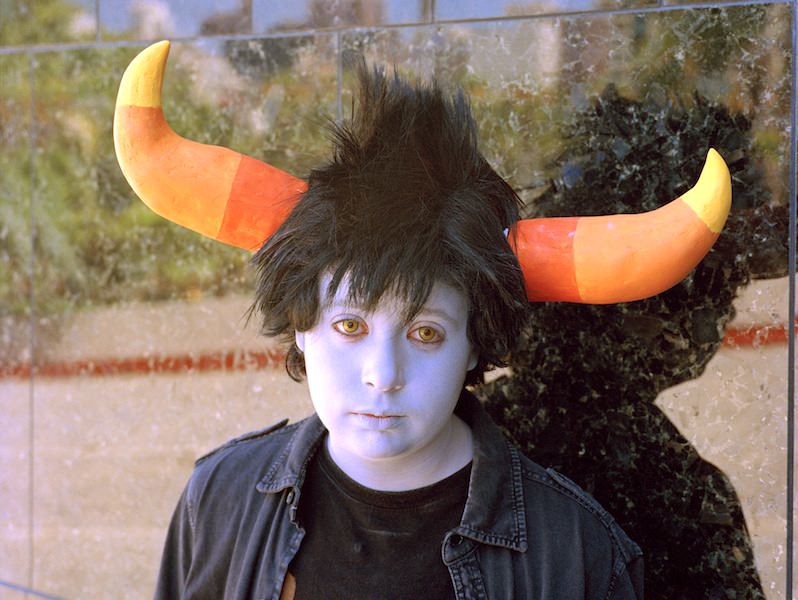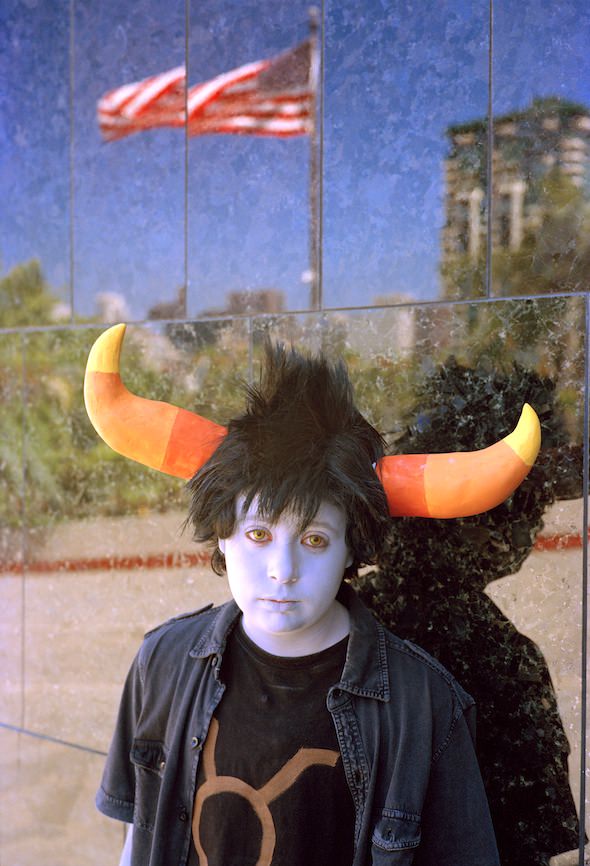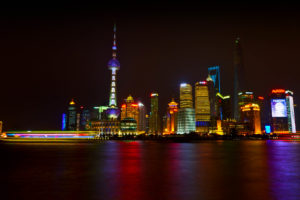Dreams of America: Work in Progress
Can the American imaginary be depicted?

“Boy With Horns”: From the 2012 San Diego Comic Con.Lena Herzog
In “Dreams of America,” my photography show opening Friday at the Maya Polsky Gallery in Chicago, the subjects — Americans — live through, and act out, their dreams of self, their country’s history and their hopes for the future. Some of these dreamers appear bitterly nostalgic; others are childlike and optimistic; quite a few seem completely, even exotically, divorced from reality, sleepwalking through a dangerous delusion.
Can one capture dreams in a photograph? Each day, as we move through the world, we give ourselves away, revealing our inner lives. Dreams can be photographed, manifested in the ceremonious exhibition of ourselves. The most ardent wishes and visions from the spectacle that plays out in our heads frequently translate in a display of costume and gesture.
Over the past 15 years, I have made it my work to create catalogs of such manifestations around the world. My first three books of photography dealt exclusively with this subject in Spain, India and Tibet. Contextualized by the rituals of bullfight, flamenco and Buddhist pilgrimages, I concentrated on the psychological underpinnings of ritual participation. In these countries, the ceremonies are almost exclusively historical. Here, in the United States, the ritualized costumes and rites are projected as much into the future as they refer to the past.
I grew up in Russia’s Ural Mountains and immigrated to the United States in 1990. I was naturalized in 1999. I am part stranger, part citizen in America. My work is an ongoing exploration of my still-new home in all its elusive mystery. “Dreams of America” is work in progress.
Can the American imaginary be depicted? Can I capture using my eye, my instincts and my camera, the dreams of my subjects? Can I make them evident to the viewer? After several years of research, shooting and printing, living on the road in this country, I decided that I shall try to do that: hold a mirror of my own to the varied expressions of the American Dream.
I began traveling to political rallies and discovered that the extreme right wing readily parades its views, as its adherents venerate a fictitious America of the 1950s pre-civil rights era. Their desperation and exhaustion with being stuck in the present is tangible and is reflected in their dress code; nostalgic costumes and adornments of the ’50s. An elderly couple dressed as the American flag, complete with red-white-and-blue-striped top hats, suspiciously eye me from their folding chairs. They miss that falsely homogenous, monochromatic America, and want what never was “back.” At a Glenn Beck rally on the anniversary of Martin Luther King’s “I Have a Dream” speech, these people were saying, “We too have dreams.”
A few years ago, I photographed one of my favorite cities, New Orleans, and its inhabitants: streetwalkers, Mardi Gras float riders, local actresses. I met a woman named Antoinette. She was once married to blues singer Ernie K-Doe, known for a hit single called “Mother-in-Law.” Antoinette ran a bar by the same name. In the corner of her bar stood a mannequin made in the likeness of her late husband. “Why did you have him made … like this?” I asked her. “Because I miss him, baby,” she answered.
I have returned several times to Comic-Con in San Diego to photograph people who congregate to celebrate comics. Most of the participants were earnest and single-minded in their devotion to specific characters rather than to any political agenda. “I do not look that much different normally,” said a girl with a spider necklace. A woman who looked like a full-frame Roy Lichtenstein painting complained that her arm got tired from holding up her thought bubble but insisted on the precise rendering.
These people are not smothered by their fantasies — they are their fantasies. Their metamorphosis is complete.
Creating an encyclopedia of the American imaginary is not my ambition, even if it were possible. My intention is to create an American dreamscape, although it is doomed to be an incomplete one. I offer not a critique, but dreams as they manifest themselves, grandiose and ritualized, futuristic and retrograde, beautiful and scary. America — a reverie.
Featured below is a slideshow of 14 photographs from Lena Herzog’s “Dreams of America” series. View them on full-screen mode and click “Show Info” for caption information. Or view the collection in its entirety here.
Notes from the photographer’s diary (translated):
At the Glenn Beck rally “Restoring Honor,” Aug. 28, 2010
When I arrived in Washington, D.C., at seven in the morning, the lawn leading to the Lincoln Memorial was flooded with people. Some were standing, others slept on the ground; very few moved for the fear of losing their long-saved spots. Everyone tried to get as close to the stage as possible. They talked about “Sarah and Glenn” as though they were discussing their favorite family members. The chummy atmosphere was sometimes interrupted by patriotic chants. I heard “The Star-Spangled Banner” at least 30 times. When I first started walking around, I wanted to buy a T-shirt from one of the entrepreneurial vendors. But I soon decided against buying anything: the cross, the flag lapel pin or any sign that would ingratiate me to the people I planned to photograph. I never took out the wide-angle lens that distorts the subject. Just the portrait lens — very straight. Let’s see it all for what it is, I thought, and not make it too easy.
I was frequently asked where I was from. My accent and the lack of any Republican or tea party paraphernalia gave me away. This was the one time I knew I could not tell the truth — that I am a Russian who has lived in America for more than half of her life. Instinctively, I lied: South Africa. “Tough times there, eh?” said a man wearing a top hat printed with the American flag.
I started milling around, trying not to step on anyone. A lot of people were sleeping on their blankets or directly on the grass. They had been there since yesterday, and most of them had taken free buses to D.C., the cost underwritten by the Koch brothers’ bankrolling the event’s high production value.
The moment I trained my camera on a man with an Obama-Hitler poster, a hand went over my lens. Two men in orange “Marshal” T-shirts accosted my subject and told him in no uncertain terms: “Either you put your poster away, or we trash it.” The marshals had their hands full. They were facing the conundrum that the people who came from Ohio or Tennessee or Texas did not come to be quiet; they came to be angry, to present themselves. Many grumbled that politics were not being brought up — they quarreled and shouted at each other, even though they were all in agreement. Then a preacher led a prayer. Everyone was suddenly quiet and repeated it after him. I do not know exactly how many people were there — many. The crowd prayed and then said the Pledge of Allegiance in unison. “Amen,” said some 300,000 people. It was not in a church, but in front of the Washington Monument, President Lincoln’s statue looking calmly at them from the other side. This threw me into a cold sweat, despite the dreadful heat that day. I loaded a new roll of film, and, looking through my lens at the thousands, saw a man who seemed to be a Harley-Davidson biker, and thought I ought to open my aperture half a stop to see his face better under the black umbrella. “When I see that nigger go up Air Force One, my stomach turns,” I heard behind me. I turned around, and I saw two ordinary people.
Featured below is a slideshow of 14 photographs from Lena Herzog’s “Dreams of America” series. View them on full-screen mode and click “Show Info” for caption information. Or view the collection in its entirety here.
Independent journalism is under threat and overshadowed by heavily funded mainstream media.
You can help level the playing field. Become a member.
Your tax-deductible contribution keeps us digging beneath the headlines to give you thought-provoking, investigative reporting and analysis that unearths what's really happening- without compromise.
Give today to support our courageous, independent journalists.






You need to be a supporter to comment.
There are currently no responses to this article.
Be the first to respond.